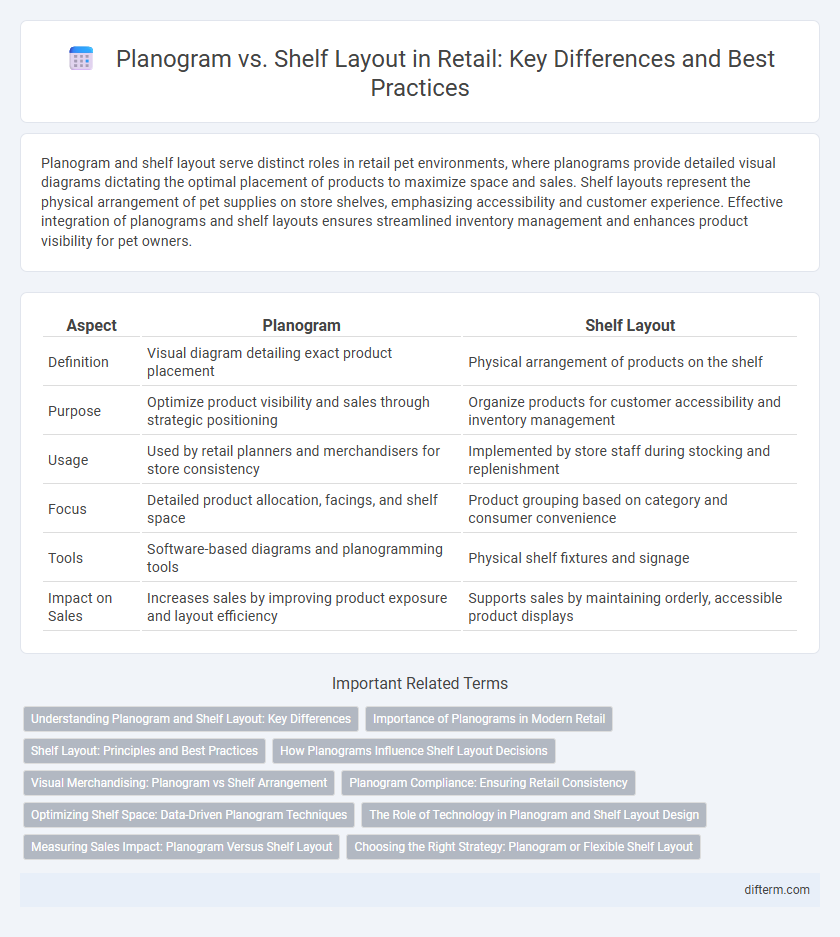Planogram and shelf layout serve distinct roles in retail pet environments, where planograms provide detailed visual diagrams dictating the optimal placement of products to maximize space and sales. Shelf layouts represent the physical arrangement of pet supplies on store shelves, emphasizing accessibility and customer experience. Effective integration of planograms and shelf layouts ensures streamlined inventory management and enhances product visibility for pet owners.
Table of Comparison
| Aspect | Planogram | Shelf Layout |
|---|---|---|
| Definition | Visual diagram detailing exact product placement | Physical arrangement of products on the shelf |
| Purpose | Optimize product visibility and sales through strategic positioning | Organize products for customer accessibility and inventory management |
| Usage | Used by retail planners and merchandisers for store consistency | Implemented by store staff during stocking and replenishment |
| Focus | Detailed product allocation, facings, and shelf space | Product grouping based on category and consumer convenience |
| Tools | Software-based diagrams and planogramming tools | Physical shelf fixtures and signage |
| Impact on Sales | Increases sales by improving product exposure and layout efficiency | Supports sales by maintaining orderly, accessible product displays |
Understanding Planogram and Shelf Layout: Key Differences
Planograms are detailed visual representations that specify product placement on retail shelves based on data-driven strategies to optimize sales and customer experience. Shelf layouts refer to the physical arrangement of products within store aisles, influenced by store design and shopper behavior but less prescriptive than planograms. Understanding the distinction helps retailers implement strategic merchandising plans that maximize space utilization and drive revenue growth.
Importance of Planograms in Modern Retail
Planograms play a critical role in modern retail by optimizing product placement to maximize sales and enhance customer experience. They provide a standardized visual guide that ensures consistent shelf layout across multiple locations, improving inventory management and reducing stockouts. Retailers leveraging planograms achieve higher shelf productivity and better alignment with consumer buying behavior.
Shelf Layout: Principles and Best Practices
Shelf layout in retail maximizes product visibility and accessibility by organizing items based on shopper behavior and sales data. Key principles include maintaining logical product groupings, ensuring eye-level placement for high-margin products, and optimizing shelf space to balance variety and stock levels. Best practices involve regular planogram updates, clear signage, and leveraging data analytics to adapt layouts to consumer trends, enhancing both customer experience and sales performance.
How Planograms Influence Shelf Layout Decisions
Planograms serve as strategic blueprints that precisely dictate product placement on shelves, optimizing visibility and customer flow to maximize sales. Retailers utilize planograms to allocate shelf space efficiently, ensuring high-demand and high-margin items receive prime positioning, which directly influences the overall shelf layout. By analyzing shopper behavior and sales data, planograms drive data-informed shelf layout decisions that enhance product assortment and improve inventory turnover.
Visual Merchandising: Planogram vs Shelf Arrangement
Planograms specify the precise placement of products on shelves to maximize visual appeal and sales effectiveness by guiding shelf arrangement in retail stores. Shelf layout focuses on the physical organization and spacing of products, balancing accessibility and aesthetic display to enhance the shopper's experience. Effective visual merchandising integrates planogram adherence with smart shelf arrangement, driving customer engagement and boosting revenue.
Planogram Compliance: Ensuring Retail Consistency
Planogram compliance is critical in retail to maintain consistent product placement and optimize shelf space utilization. Ensuring adherence to the planogram facilitates improved inventory management, enhances customer shopping experience, and maximizes sales potential by presenting products in a strategic, standardized manner. Retailers achieving high planogram compliance reduce out-of-stock issues and increase operational efficiency across multiple store locations.
Optimizing Shelf Space: Data-Driven Planogram Techniques
Planogram techniques utilize sales data, customer behavior analytics, and inventory turnover rates to strategically arrange products, maximizing shelf space efficiency and boosting sales. Shelf layout, while focused on visual aesthetics and product accessibility, often lacks the precision and adaptability offered by data-driven planograms. Retailers leveraging planogram software can optimize product placement based on real-time insights, improving stock visibility and minimizing out-of-stock situations.
The Role of Technology in Planogram and Shelf Layout Design
Advanced software tools leverage machine learning algorithms to optimize planogram and shelf layout designs by analyzing consumer behavior and sales data. Digital planogram solutions enable real-time adjustments, enhancing product placement accuracy and inventory management efficiency. Integration of augmented reality (AR) further allows retailers to visualize and simulate shelving strategies, improving decision-making and maximizing retail space utilization.
Measuring Sales Impact: Planogram Versus Shelf Layout
Measuring sales impact between planograms and shelf layouts reveals that planograms provide a strategic visual representation designed to optimize product placement based on data-driven consumer behavior insights. Shelf layouts, while more general, influence sales by determining product accessibility and visibility on physical shelves. Retailers leveraging planograms typically see improved sales performance through enhanced category management and inventory allocation.
Choosing the Right Strategy: Planogram or Flexible Shelf Layout
Selecting between a planogram and a flexible shelf layout hinges on retail goals and product variety; planograms offer structured merchandising that maximizes space and ensures brand consistency, while flexible shelf layouts accommodate frequent inventory changes and diverse customer preferences. Retailers aiming for standardized product placement and enhanced visual merchandising benefit from planograms, especially in chain stores. Conversely, stores with fluctuating inventory or niche markets gain agility through flexible shelf layouts that support dynamic product arrangements and personalized shopping experiences.
Planogram vs Shelf Layout Infographic

 difterm.com
difterm.com